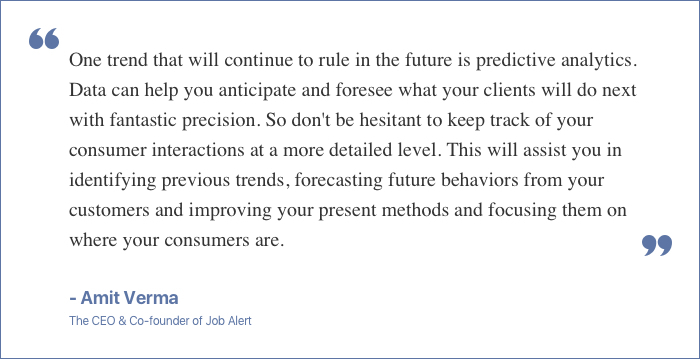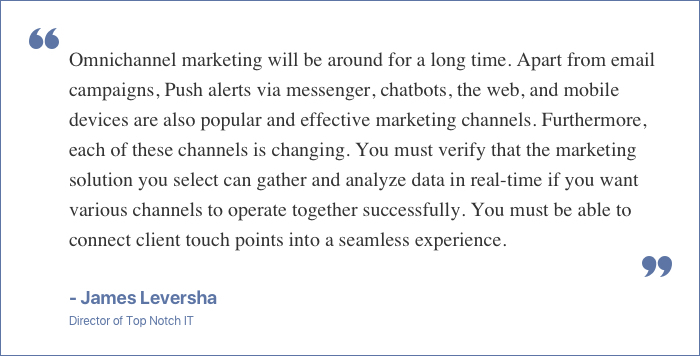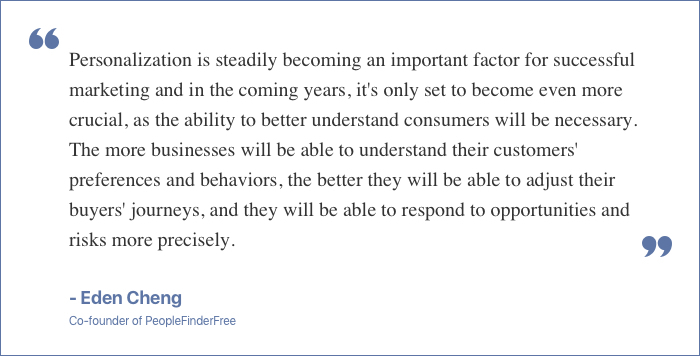Abstract:
Data has become one of the most valuable assets for any organization. The most successful marketers are already leveraging data to get maximum results from their marketing campaigns. Data-driven marketing is all set to revolutionize online commerce with each passing day. However, not every organization knows how to work with data effectively. GoodFirms surveyed 207 marketing experts to gather valuable insights on data-driven marketing. The research offers information on the benefits, challenges, elements of a successful data-driven marketing strategy, metrics to measure the campaign's success, and lastly, the data-driven marketing trends to expect in the future.
Table of Contents:
How Effective is Data-Driven Marketing?
Potential Challenges of Data Driven Marketing
Important Elements of a Successful Data-Driven Marketing Strategy
Introduction
Data-driven marketing is the marketing insights derived from analyzing data gathered about customers, and about the company’s performance, market share, etc. Data-driven marketing is a broad concept that includes understanding the existing data, determining the data to be collected, and applying the same data to the business's marketing efforts. The process is the most efficient way to work towards data-driven customer experience management.
Data-driven marketing has delivered evident results for organizations in terms of customer loyalty, market growth, and customer engagement. Marketers who appreciate data’s value for driving higher customer engagement levels are reaping huge benefits in their marketing campaigns. (1). However, there are also some significant challenges that marketers face in data-driven marketing. Due to this many organizations are still not using data-driven marketing to its maximum potential.
Taking this into consideration, the research article looks into various aspects of data-driven marketing, including its benefits, challenges, essential elements of a successful strategy, and crucial metrics. Lastly, the research further highlights the upcoming trends in the industry.
How Effective is Data-Driven Marketing?
Data-driven marketing is a necessity in today's marketing strategies if a brand wants to deliver a completely personalized experience to its customers. That's because data-driven marketing focuses on demand-based marketing activities. Apart from this, the significant benefits of data-driven marketing include assistance in creating personalized content and campaigns (65.2%), strategic decision-making (62.3%), and multi-channel optimization (44.9%).

The Primary Benefit of Data-Driven Marketing is Personalized Content & Campaigns
Data gives businesses detailed insights into their customers about their interests, online activities, lifestyle, and much more. This information enables marketers to create highly targeted campaigns with a unique and personalized message for every customer. Such marketing campaigns resonate with them and attract the customers to check out the business. Not only that, but data-driven marketing provides a holistic picture of current as well as potential customers.
62.3% of Marketers Consider Strategic Decision Making as a Significant Benefit for Data-driven Marketing
As per 62.3% of surveyed experts, data-driven marketing is beneficial as it enables strategic decision-making. It makes sense because the more actionable data marketers have on hand, the better they will predict a customer's reaction to a particular message. Data driven marketing frees up strategic employees from administrative tasks (2) and the data on hand allows marketers to make faster and more accurate strategic decisions that discard what is not working and optimize what works.
44.9% Vote Multi-channel Optimization as Another Crucial Benefit for Data-driven Marketing
A marketing campaign will not perform the same on all platforms. A marketing technique that works on Facebook may or may not give the same results on Instagram. Also, social media marketing has an entirely different approach than email marketing. In such a scenario, data-driven marketing helps in identifying what works for which channel. Companies that implemented data-driven marketing have eventually discovered that most of their leads come from one or two channels.
After identifying the key channels, multi-channel optimization is all about sensible allocation of marketing budget, and this can happen only when there is a proper understanding of your data.
Potential Challenges of Data-Driven Marketing
Despite the multitude of benefits that follow the data-driven marketing approach, executing such a strategy is not a piece of cake. Data-driven marketing comes with a whole set of challenges that marketers need to overcome. The top 3 challenges as per survey respondents are finding & maintaining high-quality data (53.6%), targeting segmented audiences (46.4%), and making meaningful connections (46.4%). The first step to efficiently overcome the challenges is to know them.
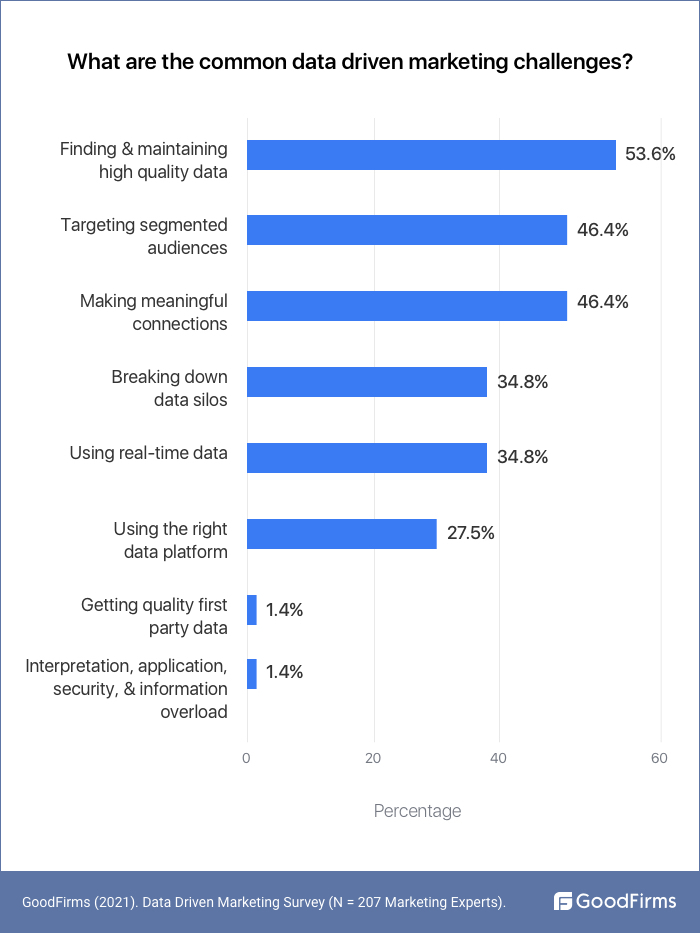
53.6% Surveyees Consider Finding & Maintaining High-Quality Data as the Biggest Challenge in Data-Driven Marketing
A business generates enormous amounts of data daily. But that itself is not enough to say that the data will yield actionable insights. For a marketing campaign to be truly data-driven, high-quality, and latest data is a prerequisite. New models with old data are still likely to provide inaccurate results.(3) The challenge of finding and maintaining high-quality data is that there are multiple sources of data today, and various sources also mean numerous formats. Organizations can tackle this challenge by ensuring that all of their data is updated to the last minute, there are no silos, and everyone maintains data in a centralized system.
For 46.4% of Marketers, Targeting Segmented Audiences is their Greatest Challenge in Data-Driven Marketing
The traditional advertising method meant sending a common message to the masses and hoping to get enough traction. But in the case of data-driven marketing, marketers can segment the audience into specific groups of people and send them relevant messages. This idea sounds perfect for achieving the result, but 46.4% of surveyed marketing experts find segmenting and targeting the audience a challenge. Some reasons for segmentation proving to be a hurdle are as follows:
- Cost of the process
- Understanding that customers can belong to many segments
- Keeping the segments specific
- Choosing the right segments to focus on
- Embedding segmentation in the organization
Making Meaningful Connections is Another Considerable Challenge of Data-Driven Marketing
Customers are already bombarded with a whole lot of content and offers across multiple channels. If a business wants to rise above the noise, it must first establish a connection with the audience. It has become easier for marketers to collect data from multiple channels, but 46.4% still struggle to make meaningful connections with customers. Possible reasons for marketers facing this challenge are that they are not collecting the correct type of data or don't have the right processes to help them gather meaningful insights. A brand can humanize its sales and marketing efforts by following these steps:
- Formulate a strategy
- Map the data
- Find a balance between the data on hand and the required data.
Important Elements of a Successful Data-Driven Marketing Strategy
Diving straight into data-driven marketing can be overwhelming because there is a lot of information to collect and iterate as per relevancy. . Secondly, the process may seem high-tech if a business is not already tech-savvy. However, investing in data extraction software, data analysis software, or database management software should help companies of any size mitigate these issues.
Every marketing strategy has some essential elements for success. In the case of data-driven marketing, according to our surveyees, these elements are; creating buyer personas & customer-focused content (26.1%), the attitude that data goes beyond numbers (15.9%), and developing models to predict & optimize business outcomes (14.5%).
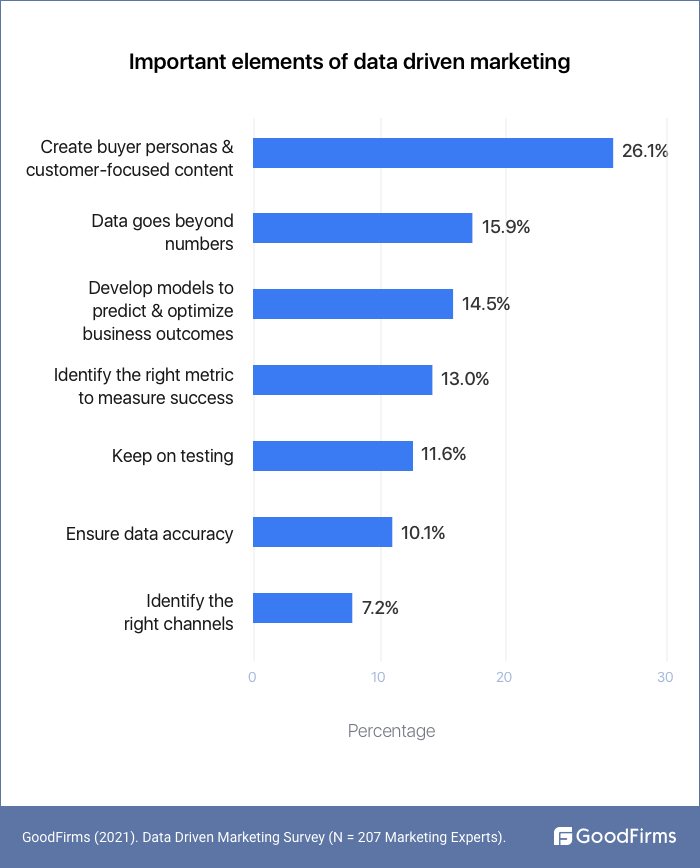
Creating Buyer Personas & Customer-Focused Content are the Essential Elements of a Successful Strategy
Only data cannot be the basis for a marketing plan. Insights for a marketing campaign are developed after understanding the ideal customer. For that, businesses need to create buyer personas. Companies can prepare buyer personas with the help of information such as customer behavior, preferences, buying patterns, and background. Once buyer personas are ready, it becomes easier for marketers to create customer-focused content that will resonate with the audience.
15.9% of the Marketers think that Data Goes Beyond Numbers
For a data-driven marketing strategy to be successful, 15.9% of marketers think that data goes beyond numbers. Data and numbers need to be given meaning outside their numerical value. But before trying to make sense of the numbers, marketers need to define the goals and the KPIs that will impact those goals. Once it is clear how the KPIs can positively or negatively affect the progression towards the goal, the data points become more tangible than just numbers on a data sheet.
14.5% believe in Developing Models to Predict & Optimize Business Outcomes
The third element of a successful data-driven marketing strategy is developing models to predict and optimize business outcomes. The digital age brought two new ways to measure and optimize marketing: analytics and technology.(4) Data is necessary, but the analytics models enable managers to predict and optimize business outcomes. However, while developing the model, managers don't start with data. The right way is to identify the business opportunities, and then the models can improve performance.
Most Important Metrics for Data Driven Marketing
Tracking the right set of metrics will guide a marketing campaign towards success. Some of these metrics are more important than others. A risk in tracking the wrong metrics is that the strategy can quickly become misguided. Keeping this in mind, the top metrics for data-driven marketing as per surveyed experts are conversion rate (37.7%),return on investment (17.9%), and customer lifetime value (11.6%).

37.7% of the Marketers point out Conversion Rate as the Most Important Metric of data-driven marketing
Conversion rate is considered the most important metric as it offers valuable insights into the effectiveness of content, campaigns, and ultimately the business's profitability. For instance, a website sets up a landing page for a gated ebook. The page received substantial traffic after all the marketing efforts, but very few visitors completed the form to download the ebook. The low conversion rate shows that the ebook is of interest to people, but there is a loophole in the Form.
Also, the conversion rate metric will help marketers to bring down the expenditure of online marketing campaigns by discovering the "friction points" in the conversion path. Moreover, the cost per acquisition also reduces with the increase in conversion rate. The five prevalent methods to improve conversion rate in data-driven marketing are:
- Customer journey analysis
- A/B testing
- Usability testing
- Website personalization
- Cart abandonment analysis
17.9% Surveyees Opted for Return on Investment (ROI) as a Crucial Metric for Data Driven Marketing
ROI shows the effect of all the marketing efforts on the bottom line of the business. Using the metric on a program or campaign level will enable marketers to decide about future spendings. For instance, they can identify the strategies that work and re-invest for the next campaign. Moreover, true marketing ROI is much more than just the revenue. It should also increase customer satisfaction, engagement, and brand awareness. A few things that a marketer learn from measuring the ROI are:
- Where to spend the dollars?
- How to pivot the marketing strategy?
- Which tools to use for successful marketing?
The Customer Lifetime Value (CLV) Metric Ranks Third as a Crucial Metric for Data-Driven Marketing
Customers are the lifeline of a business. It is ultimately their perception of a business that will lead to its success or failure. The customer lifetime value (CLV) metric predicts the average amount of money that a customer will spend on the business during their lifetime. An example of calculating CLV is: If a customer buys products/services from a company for ten years and pays $10 per year. Here, their customer lifetime value is $100 minus the amount spent on acquiring that customer.
There are different methods to calculate the CLV. It can either be historical or predictive.(5)The calculation method will also vary based on the adopted business model.
Following are some ways to increase the CLV:
- Segment the email & SMS lists
- Take advantage of the freemium model
- Funnel traffic from social media
- Offer a seamless buying experience
- Option of loyalty programs for valuable customers
Data-Driven Marketing Trends
The amount of available data is growing exponentially with time, and so are the advanced marketing strategies along with it. It has become difficult for marketers to keep up with the pace of the marketing world. To make the most out of data marketing efforts, it is essential to keep up with the latest trends in the industry.
Insights gained from our research partners clearly establish the below trends in Data Driven Marketing:
Increasing Use of Predictive Analytics
Predictive analytics uses data, algorithms, and machine learning techniques to predict future outcomes based on past data. Machine learning-backed predictive analytics can help improve decision-making for marketers.(6) Predictive analysis aims to understand what will happen in the future from what has happened in the past. A frequently asked question regarding predictive analytics is "Why now?". More and more organizations are turning to it because:
- Increasing volumes & types of data
- More interest in using data to get valuable insights
- User-friendly software
- More arduous economic conditions & the need for a competitive edge
In the case of B2C businesses, predictive analysis enables them to focus their ad spending on the right people. It ultimately results in a higher return on investment.
The steps of an analytical life cycle are as follows:
- Know the problem to be solved - A business should be clear on what they want to know about the future based on the past to start with predictive analysis.
- Data preparation - Data comes from a lot of places. The requirement here is clean data ready to be analyzed. For that, a business will need someone with experience in data management.
- Build analytical models - User-friendly software in the market has made it easy for anyone to build analytical models. But, a data analyst is the one who will refine these models and determine the best performer.
- Deploying a team - Predictive analysis is not a single person's job. It includes people who understand the business problem that needs to be solved and the business goals that need to be kept track of. The team should consist of a data analysis expert(to prepare data for analysis and to refine the models), an IT person (to make sure that the proper infrastructure is in place), and an executive sponsor (to make the analytics goals a reality.)
Omnichannel Marketing
It has become essential that a company's marketing message remains consistent across platforms and devices. When omnichannel marketing is combined with data-driven marketing, it becomes possible to achieve this, all the while improving the customer experience as a whole.
One of the common techniques of implementing an omnichannel approach in data-driven marketing is identity resolution. Identity resolution is the ability to recognize any entity along with the associated relationships. Moreover, identity resolution should be done accurately and consistently based on an entity's physical and digital attributes. The identity resolution technique attempts to coordinate marketing efforts across channels based on individual characteristics and the technology footprint of every customer.
For businesses planning to automate their omnichannel marketing campaign, the three-step approach stated below will help:
- Establish the data sources, including mobile apps, social media, influencer campaigns, videos, influencer campaigns, podcasts, or any other media. Also, take into consideration how each individual will use the source concerning the campaign goals.
- Determine modeling and attribution so that marketers can confirm if the data is categorized correctly and displayed. Good marketing decisions can be made only if high-quality data is available as and when needed.
- Constantly improve data quality by using data checks and validation to verify the accuracy and reliability of the available information. Constant checks are required as data is continuously updated.
Personalized User Experiences
In a world where customers are constantly consuming content from all platforms, personalized content is what makes a mark. 90% (7) of leading marketers believe that personalization contributes significantly to a business's profitability. Despite marketing personalization being one of the most effective and powerful tactics, many marketers are not using it to their full potential.
It is also time marketers understand that personalization goes beyond using the first name in emails. In reality, personalization in marketing is all about on-site personalized experiences. An example is showing customers a list of items they have been searching for price comparisons in the past few days, and recommending as per their previous purchases
In the case of emails, it can be the subject line related to the reader's interest. These examples completely change the user experience for customers and inspire them to engage with the brand.
The reason behind increased conversions with personalized marketing is simple. Customers see that the brand is paying attention to them as individuals and not defining them by a category or demographic.
Increasing Importance of First-Party Data
First-party data is the information that brands collect directly from the customers and, more importantly, the customers knowingly provide it. First-party data can come from multiple sources such as websites, surveys, CRM, social media, and customer feedback. As times have changed, 92% (8) of leading marketers think that using first-party data to understand what the audience wants constantly is critical for growth.
The growing concern among people regarding data privacy and privacy regulations to combat the same has made it difficult for brands to collect third-party data. Consumers are now finding ways to protect themselves from data exposure better. For instance, they have realized that browser choice matters. Google Chrome may be the most popular browser, but it creates a way for Google to optimize its data extraction process from the user's internet behavior. So, people are using alternatives such as Firefox for browsing.
Thus, first-party data is becoming more critical and the need of the hour too.
First-party data is vital because brands collect it themselves and is usually the most reliable data available. Moreover, in most cases, it can be collected at no cost. So, again it is the least expensive option.
Now that the role of first-party data is evident in the coming times, below is a breakdown of some common ways that organizations use this data for their marketing strategies:
Make a plan
While using first-party data, it is critical to create a plan beforehand. The following steps can help an organization achieve greater efficiency while analyzing and implementing data:
- Know what data is being collected
- Create a checklist
- Break up the responsibilities
Optimize the website
First-party data will reveal the user-friendliness of a website. It is because first-party data can track:
- Time users spend on the website
- Level of engagement with certain aspects of the website
- Frequency of users returning to the website
- Any feedback related to the website's performance
Advertising & Pay-Per-Click
Online business owners know the importance of digital advertising. The role of first-party data here is that it can be used to enhance the effectiveness of the PPC technique. First-party data can be integrated with PPC strategies by connecting an analytics tracker to the website. Such integration will lead to:
- An in-depth understanding of the leads
- Comparison of new vs. returning users
- Better search accuracy related to SEO & targets
Email & SMS Lists
One of the most popular ways organizations use their first-party data is by adding the users to their marketing list. This is usually done when customers input their contact information for:
- Making a purchase
- Submitting a question
- Receiving discount codes & coupons
- Staying updated on announcements
In an attempt to collect as much first-party data as possible, organizations should not forget to give users the option to opt-out of such messages. This way, they can avoid any future conflicts with the customers.
Key Findings
- Data-driven marketing has proved to maximize the ROI of marketing campaigns.
- The primary benefit of data-driven marketing, as per experts, is it helps in creating personalized content & campaigns.
- A significant challenge noted by 53.6% of surveyees with data-driven marketing is finding and maintaining high-quality data.
- For a successful data-driven marketing strategy, the primary element is creating buyer personas and customer-focused content.
- 37.7% of marketing experts think that conversion rate is the most vital metric to track the success of a data-driven marketing campaign.
- Some of the data-driven marketing trends to expect in the coming years are increasing use of predictive analytics, an omnichannel marketing approach, and a rise in using first-party data.
- Data-driven marketing is the only way forward, with more and more customers expecting a personalized experience from brands.
- The top benefits of data-driven marketing are personalized content & campaigns, strategic decision making, multi-channel optimization, and the fact that it offers consistency and longevity.
- Some of the common challenges that marketers face in data-driven marketing are finding & maintaining high-quality data, targeting the segmented audiences, and making meaningful connections.
- Creating buyer personas & customer-focused content, adopting the idea that data goes beyond numbers, and developing models to predict and optimize business outcomes are the key ingredients for a successful data-driven marketing campaign.
- The data-driven marketing metrics that should be a priority for marketers are conversion rate, return on investment, customer lifetime value, and website traffic sources.
- The data-driven marketing trends that are set to rule in the coming years are a combination of omnichannel approach with data-driven marketing, more use of predictive analytics, offering personalized user experience to customers, and the rise in first-party data.
Conclusion
The expectations, demands, and priorities of consumers are changing every day. Marketers need to strive hard to create impactful consumer connections. Leveraging data-driven marketing strategy ensures that the marketing campaigns are aligned with consumer needs, consistent, and perfectly timed.
Moreover, there is a whole range of tools, platforms, and technologies that have made it easier for marketers to unleash data-driven marketing campaigns and measure their impact in real-time. We conclude that data-driven marketing is a sustainable strategy with long-term benefits for businesses.
GoodFirms has taken extreme care to keep the research objective, empirical, and error-free. For more details or any queries related to the research please feel free to contact: [email protected].
We sincerely thank our Research Partners who participated in the survey.
About the Data Driven Marketing Survey:
GoodFirms surveyed 207 marketing experts across the world to gather insights on the latest data driven marketing trends.
The survey participants belonged to the below demographics:
Type of Business:
B2B - 60.9% and B2C - 39.1%
Size of Business:
- Small businesses (Individuals/Freelancers) - 2.9%
- Small businesses (2 - 9 employees) - 23.2%
- Small businesses (10 - 249 employees) - 72.5%
- Medium businesses (250-499 employees) - 1.4%
Declaration of conflict
GoodFirms declares that we have no conflicts of interest to report regarding the present study.
About GoodFirms’ Research:
GoodFirms is the global leader in IT research and listing. We empower businesses everywhere with high-quality research insights that unleash competitive advantage for companies. Our research aims to provide the right strategies, best practices, and deep expertise to businesses for their exceptional growth.
References
- https://images.forbes.com/forbesinsights/StudyPDFs/Turn-DataDrivenCustomerCentric-REPORT.pdf
- ibid
- https://www.mckinsey.com/business-functions/marketing-and-sales/our-insights/the-big-reset-data-driven-marketing-in-the-next-normal
- https://www.researchgate.net/publication/352867355_Are_Marketers_ready_to_deliver_the_Data_Driven_Marketing_as_promise
- https://web-ainf.aau.at/pub/jannach/files/Journal_TKDD_2021.pdf
- https://dl.acm.org/doi/abs/10.1145/3368756.3369024
- https://www.thinkwithgoogle.com/future-of-marketing/creativity/marketing-personalization-statistics/
- https://www.thinkwithgoogle.com/consumer-insights/consumer-trends/first-party-data-user-statistics/
